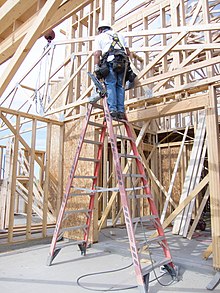Residential construction
The most popular method of residential construction in North America is wood-framed construction. Typical construction steps for a single-family or small multi-family house are:
- Develop floor plans and obtain a materials list for estimations (more recently performed with estimating software)
- Obtain government building approval if necessary
- Clear the building site
- Survey to stake out for the foundation
- Excavate the foundation and dig footers.
- Pour a foundation and footers with concrete
- Build the main load-bearing structure out of thick pieces of wood and possibly metal I-beams for large spans with few supports. See framing (construction)
- Add floor and ceiling joists and install subfloor panels
- Cover outer walls and roof in OSB or plywood and a water-resistive barrier.
- Install roof shingles or other covering for flat roof
- Cover the walls with siding, typically vinyl, wood, or brick veneer but possibly stone or other materials
- Install windows
- Frame interior walls with wooden 2x4s
- Add internal plumbing, HVAC, electrical, and natural gas utilities
- Building inspector visits if necessary to approve utilities and framing
- Install insulation and interior drywall panels (cementboard for wet areas) and to complete walls and ceilings
- Install bathroom fixtures
- Spackle, prime, and paint interior walls and ceilings
- Additional tiling on top of cementboard for wet areas, such as the bathroom and kitchen backsplash
- Install final floor covering, such as floor tile, carpet, or wood flooring
- Install major appliances
- Unless the original owners are building the house, at this point it is typically sold or rented.
New construction techniques and sustainability
As efficiency codes have come into effect in recent years, new construction technologies and methods have emerged. University Construction Management departments are on the cutting edge of the newest methods of construction intended to improve efficiency, performance and reduce construction waste.
New techniques of building construction are being researched, made possible by advances in 3D printing technology. In a form of additive building construction, similar to theadditive manufacturing techniques for manufactured parts, building printing is making it possible to flexibly construct small commercial buildings and private habitations in around 20 hours, with built-in plumbing and electrical facilities, in one continuous build, using large 3D printers.[12] Working versions of 3D-printing building technology are already printing 2 metres (6 ft 7 in) of building material per hour as of January 2013, with the next-generation printers capable of 3.5 metres (11 ft) per hour, sufficient to complete a building in a week.[13] Dutch architect Janjaap Ruijssenaars's performative architecture 3D-printed building is scheduled to be built in 2014.
In the current trend of sustainable construction, the recent movements of New Urbanism and New Classical Architecture promote a sustainable approach towards construction, that appreciates and develops smart growth, architectural tradition and classical design.[15][16] This is in contrast to modernist and short-lived globally uniform architecture, as well as opposing solitary housing estates and suburban sprawl.[17] Both trends started in the 1980s.
The construction site may be shut down due to bad weather. Erecting scaffolded tents over the site may reduce the number of lost work days, increasing productivity.

No comments:
Post a Comment